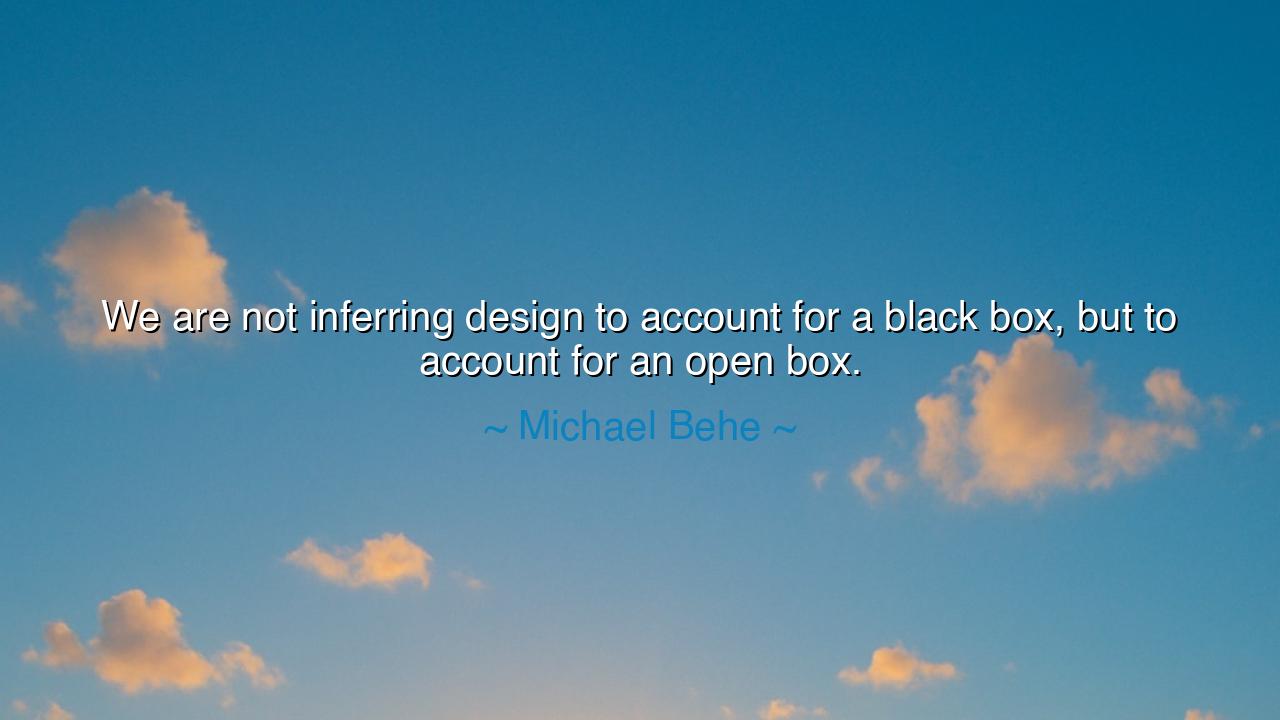
We are not inferring design to account for a black box, but to
We are not inferring design to account for a black box, but to account for an open box.






In the modern discourse of science and faith, where wonder meets inquiry and reason wrestles with mystery, Michael Behe, the biochemist and philosopher of intelligent design, once declared: “We are not inferring design to account for a black box, but to account for an open box.” At first, these words may seem bound to the laboratories of molecular biology, but they echo with a wisdom far deeper — one that transcends science and reaches into the heart of how humankind seeks meaning. Behe speaks of understanding, of how discovery, rather than diminishing wonder, can deepen it. He reminds us that design is not the refuge of ignorance, but the recognition of order in what we already know.
To comprehend this, we must first understand what the black box represents. In ancient and modern thought alike, the “black box” symbolizes what is hidden — the mystery whose workings are unknown. Once, men saw the rising sun and did not know what made it ascend, so they ascribed it to gods and spirits. But Behe’s words tell a different tale: we are not assigning divine design to what we cannot explain — to darkness — but rather to what we can see with clarity and awe. In his field of biochemistry, the open box reveals the intricate machinery of life, the symphony of molecules that work together in astonishing precision. And from that revelation, he does not see chaos or chance — he sees intention, structure, and meaning woven into the very fabric of existence.
This thought carries the spirit of both scientist and sage. It calls to mind the ancient philosophers who, gazing upon the cosmos, did not see mere randomness but logos, a rational order that binds the universe. The Stoics called it divine reason; the Pythagoreans found it in the music of numbers. Likewise, when Behe gazed through the microscope at the cell, he saw not confusion but harmony — not a black box of mystery, but an open box of revelation. He saw that the more one uncovers the mechanisms of nature, the more profound the sense of purpose becomes. His statement is not an argument for ignorance, but a celebration of knowledge that points beyond itself.
Consider the story of Isaac Newton, who laid bare the laws of motion and gravity — who made the heavens calculable. Some feared that this knowledge would strip the world of wonder. But Newton himself, upon revealing these elegant laws, declared that he had only “picked up shells on the shore of the great ocean of truth.” For him, the order he discovered did not banish the divine; it magnified it. He saw the open box of the universe — not hidden in mystery, but radiant with mathematical beauty — and he recognized design, not in what was unknown, but in what was understood. So too does Behe remind us: understanding does not extinguish awe; it clarifies it.
The quote, then, is a lesson about perception. The unwise believe that to uncover the workings of nature is to disprove purpose, as though design exists only where ignorance reigns. But the wise, like Behe, see deeper: that the more one learns, the more one perceives the fingerprints of intelligence upon reality. Whether one calls it divine, natural, or cosmic, there is an intelligible harmony within the apparent complexity. The open box is not a void; it is a window. And through that window, one sees not the absence of meaning, but its luminous presence.
In the ancient myths, Prometheus stole fire from the gods to bring light to mankind. Yet Behe’s fire is of another kind — the fire of understanding, which reveals that the world’s inner workings are not random, but radiant with pattern and order. This is the eternal paradox: the closer we come to understanding the mechanisms of life, the closer we stand to the mystery of its origin. To see design in the open box is to recognize that knowledge and reverence are not enemies, but allies in the pursuit of truth.
Thus, O seeker of wisdom, take this teaching to heart: do not fear the unveiling of mystery, nor believe that the discovery of cause dispels wonder. Look deeply into the open box of your own world — into art, into science, into the pattern of your days — and learn to see the hidden symmetry that sustains all things. Do not look for meaning only where light fails; look for it where light shines brightest. For every truth uncovered, every mechanism understood, every pattern revealed — all these whisper of a greater harmony that holds creation together.
And so remember the wisdom of Michael Behe: we do not invoke design to explain the unknown, but to honor the known. The open box of knowledge, when viewed with humility and awe, reveals the same wonder the ancients found in the stars. For mystery does not vanish with understanding — it only deepens. And the wise know that the more one sees, the more there is to marvel at — and the more one must bow in gratitude before the grandeur of design that surrounds us all.






AAdministratorAdministrator
Welcome, honored guests. Please leave a comment, we will respond soon